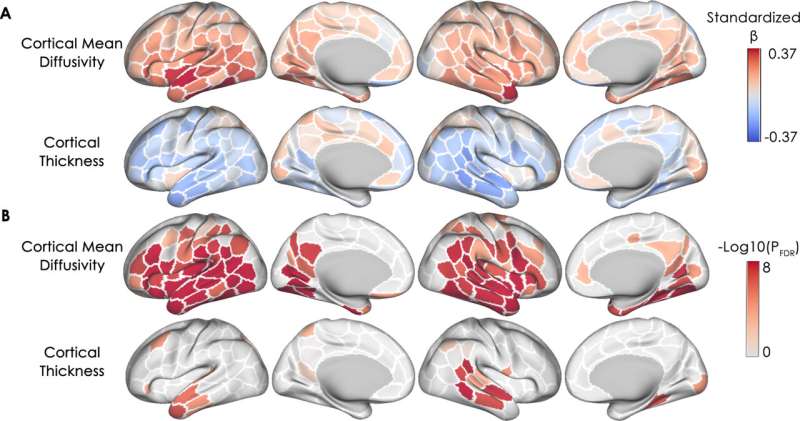This article has been reviewed according to Science X's editorial process and policies. Editors have highlighted the following attributes while ensuring the content's credibility:
fact-checked
trusted source
proofread
Spatial pattern of pathological changes in the brain can help identify dementia vulnerability early

Findings from a novel study in Biological Psychiatry: Cognitive Neuroscience and Neuroimaging, suggest that using a specialized diffusion weighted MRI scan to monitor the spatial pattern of individual cortical microstructural change in the brain may be a promising approach to characterize individuals who may be vulnerable to developing Alzheimer's disease (AD) prior to significant cognitive decline and irreversible neuronal damage.
Identifying early markers of AD-related neurodegeneration can fundamentally shift the timeline of risk identification, providing precious time for disease-modifying treatments such as those recently approved by the FDA.
First author of the study Rongxiang Tang, Ph.D., Postdoctoral Scholar, Department of Psychiatry and Center for Behavior Genetics of Aging University of California San Diego, explains, "Our research team previously found that a measure of cortical microstructure, an index of brain gray matter integrity, in cognitively healthy people in their mid-50s can help predict cognitive impairment a decade later.
"So, we were interested in examining if changes in this measure over time are linked to memory changes, and how the spatial patterns of these changes can tell us about a person's risk of developing cognitive impairment and AD. Tracking these cortical microstructural changes early on in the aging process may be beneficial for early risk identification of cognitive impairment and AD."
The study included people in their early 60s who live in the community and did not have dementia. Investigators conducted brain assessments twice with MRI scans over a period of five to six years using an index called cortical mean diffusivity that reflects the integrity of gray matter microstructure in the brain. They then compared how similar these microstructural change brain maps are to those of typical AD pathology deposition (e.g., beta-amyloid and tau) in AD patients from a different study.
Senior author Jeremy A. Elman, Ph.D., Assistant Adjunct Professor, Department of Psychiatry and Center for Behavior Genetics of Aging, UC San Diego, says, "We found that the spatial pattern of microstructural change in our participants closely resembled the typical tau pathology deposition map seen in AD patients. Importantly, the participants whose change maps had greater similarity to the tau map also showed more memory decline over the same time period.
"Because tau is considered to be a major contributor to neurodegeneration (brain shrinkage) and cognitive decline, our results suggest that tracking these cortical microstructural changes and their spatial change patterns early on in the aging process may be beneficial for early identification of risk for cognitive impairment and AD."
The index of microstructure used comes from an MRI scan and is widely available. It may detect subtle change in the brain before substantial tissue loss has occurred, so even if a person does not yet exhibit significant cognitive problems or brain shrinkage, having a spatial change pattern that looks similar to an AD patient's spatial pattern of tau accumulation, suggests that they may be experiencing the early stages of AD and are at risk of developing memory problems in the future.
Once identified, clinicians may be able to direct these at-risk people for more in-depth screening and testing such as PET imaging, which can be used for diagnosis by more directly measuring the AD pathology in the brain.
Senior author William S. Kremen, Ph.D., Professor, Department of Psychiatry and Center for Behavior Genetics of Aging, UC San Diego, says, "Our work, based on the Vietnam Era Twin Study of Aging (VETSA), highlights the value of focusing on non-traditional brain structure measures and on adults as early as midlife in AD research. It is remarkable that cortical microstructural changes are earlier and more sensitive to AD-related pathological processes and memory decline than changes in cortical thickness, which are typically used for assessing neurodegeneration/brain shrinkage in AD."
Editor-in-Chief of Biological Psychiatry, Cognitive Neuroscience and Neuroimaging Cameron S. Carter, MD, University of California Irvine, comments, "This work is the first to show that it is not only whether someone is experiencing change in cortical microstructure as measured by MRI that is important, but also the spatial pattern of these changes. Paying attention to the pattern of changes may help identify people who may be at risk for memory problems and AD in their early 60s, before significant cognitive decline or visible brain shrinkage occurs."
Based on these findings, clinicians may be able to track a person's spatial profile of cortical microstructural changes over time to identify if they are at risk of developing cognitive impairment and AD early on in the aging process. Because AD takes decades to develop, early diagnosis could improve treatment success and patient outcomes.
Moreover, clinicians may recommend risk-reducing intervention or other preventive strategies for people who do not yet have significant AD pathology in the brain but are considered to be at risk based on their diffusion weighted MRI scan based spatial change profile.
More information: Rongxiang Tang et al, Early cortical microstructural changes in aging are linked to vulnerability to Alzheimer's disease pathology, Biological Psychiatry: Cognitive Neuroscience and Neuroimaging (2024). DOI: 10.1016/j.bpsc.2024.05.012




















